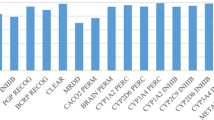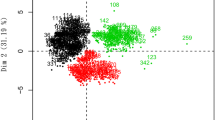Abstract
Most of present mathematical models for biological activity consider just the molecular structure. In the present article we pretend extending the use of Markov chain models to define novel molecular descriptors, which consider in addition other parameters like target site or biological effect. Specifically, this mathematical model takes into consideration not only the molecular structure but the specific biological system the drug affects too. Herein, a general Markov model is developed that describes 19 different drugs side effects grouped in eight affected biological systems for 178 drugs, being 270 cases finally. The data was processed by linear discriminant analysis (LDA) classifying drugs according to their specific side effects, forward stepwise was fixed as strategy for variables selection. The average percentage of good classification and number of compounds used in the training/predicting sets were 100/95.8% for endocrine manifestations, (18 out of 18)/(13 out of 14); 90.5/92.3% for gastrointestinal manifestations, (38 out of 42)/(30 out of 32); 88.5/86.5% for systemic phenomena, (23 out of 26)/(17 out of 20); 81.8/77.3% for neurological manifestations, (27 out of 33)/(19 out of 25); 81.6/86.2% for dermal manifestations, (31 out of 38)/(25 out of 29); 78.4/85.1% for cardiovascular manifestation, (29 out of 37)/(24 out of 28); 77.1/75.7% for breathing manifestations, (27 out of 35)/(20 out of 26) and 75.6/75% for psychiatric manifestations, (31 out of 41)/(23 out of 31). Additionally a back-projection analysis (BPA) was carried out for two ulcerogenic drugs to prove in structural terms the physical interpretation of the models obtained. This article develops a mathematical model that encompasses a large number of drugs side effects grouped in specifics biological systems using stochastic absolute probabilities of interaction Aπ k (j)) by the first time.
Similar content being viewed by others
Abbreviations
- QSTR::
-
4.9pc Quantitative structure-toxicity relationships
- MCH::
-
Markov chains
- HIV::
-
Human immunodeficiency virus
- MARCH-INSIDE::
-
Markovian chemicals in slico design
- QSAR::
-
Quantitative structure-activity relationships
- RNA::
-
Ribonucleic acid
- LDA::
-
Linear discriminant analysis
- BPA::
-
Back-Projection Analysis
- OCWLI::
-
Optimization of correlation weights of local graph invari-ants
References
Briggs, J.M., Marrone, T.J., McCammon, J.A., 1996. Computational science new horizons and relevance to pharmaceutical design. Trends Cardiovasc. Med. 6, 198–203.
Cabrera, M.A., González, D.H., Teruel, C., Pla-Delfina, J.M., Bermejo del Val, M., 2002. A novel approach to determining physicochemical and absorption properties of 6-fluoroquinolone derivatives: experimental assessment. Eur. J. Pharm. Biopharm. 53, 317–325.
Cabrera, M.A., Bermejo, S., 2004. In silico prediction of central nervous system activity of compounds. Identification of potential pharmacophores by the TOPS–MODE approach. Bioorg. Med. Chem. 22, 5833–5843.
Chou, K.-C., 1993. A vectorized sequence-coupling model for predicting HIV protease cleavage sites in proteins. J. Biol. Chem. 268, 16938–16948.
Chou, K.C., 1997. Prediction and classification of -turn types. Biopolymers 42, 837.
Chou, K.-C., 2001. Prediction of signal peptides using scaled window. Peptides 22, 1973–1979.
Chou, K.-C., 2002. Prediction of protein signal sequences. Curr. Prot. Pept. Sci. 3, 615–622.
Cronin, M.T.D., Dearden, J.C., 1995. Prediction of aquatic toxicity. Quant. Struct.-Act. Relat. 4, 1–7.
Cronin, M.T.D., 1998. Computer aided prediction of drug toxicity in high throughput screening. Pharm. Pharmacol. Commun. 4, 157–163.
Dearden, J.C., Cronin, M.T.D., Dobbs, A.J., 1995. Quantitative structure-activity relationships as a tool to assess the comparative toxicity of organic chemicals. Chemosphere 31, 2521– 2528.
Di Francesco, V., Munson, P.J., Garnier, J., 1999. FORESST: fold recognition from secondary structure predictions of proteins. Bioinformatics, 15, 131.
Estrada, E., 2001. Generalization of topological indices. Chem. Phys. Lett. 336, 248–252.
Franke, R., 1984. Theoretical Drug Design Methods, Elsevier Amsterdam.
Freund, J.A., Poschel, T., 2000. Stochastic processes in physics, chemistry, and biology. In: Lecture Notes of Physics Springer-Verlag (Eds.), Berlin, Germany.
Garcia, A.G., Horga, de la Parte, J.F., 1994. Reacciones adversas a los fármacos. In, Indice de especialidades farmacéuticas. Prescripcion racional de fármacos. INTERCON. Ed. Editores Médicos S.A. EDIMSA. Madrid. p. 155–173.
Gnedenko, B., 1978. The theory of probability. Mir Publishers (Ed.), Moscow. pp. 107– 112.
González, M.P., Morales, A.H., Molina, R., García, J.F., 2004a. A topological sub-structural approach of the mutagenic activity in dental monomers.1. Aromatic epoxides. Polymer 45, 2773–2779.
González, M.P., Morales, A.H., González-Díaz, H., 2004b. A TOPS-MODE approach to predict permeability coefficients. Polymer 45, 2073–2079.
González, M.P., González-Díaz, H., Cabrera-Pérez, M.A., Molina, R.R., 2004c. A novel approach to predict a toxicological property of aromatic compounds in the Tetrahymena pyriformis. Bioorg. Med. Chem. 12, 735–744.
González-Díaz, H., Olazábal, E., Castañedo, N., Hernádez, S.I., Morales, A., Serrano, H.S., González, J., Ramos de A., R., 2002a. Markovian chemicals ‘in silico’ design (MARCH-INSIDE), a promising approach for computer aided molecular design II: experimental and theoretical assessment of a novel method for virtual screening of fasciolicides. J. Mol. Mod., 8, 237–245.
González-Díaz, H., Ramos de A., R., Uriarte, E., 2002b. In Silico Markovian Bioinformatics for Predicting 1Hα-NMR Chemical Shifts in mouse Epidermis Growth Factor (mEGF). Online J. Bioinf. 1, 83–95.
González-Díaz, H., Gia, O., Uriarte, E., Hernádez, I., Ramos, R., Chaviano, M., Seijo, S., Castillo, J.A., Morales, L., Santana, L., Akpaloo, D., Molina, E., Cruz-Monteagudo, M., Torres, L.A., Cabrera, M.A., 2003a. Markovian chemicals ‘in silico’ design (MARCH-INSIDE), a promising approach for computer-aided molecular design I: discovery of anticancer compounds. J. Mol. Mod. 9, 395–407.
González-Díaz, H., Hernández, S.I., Uriarte, E., Santana, L., 2003b. Symmetry Considerations in Markovian Chemicals “in silico” Design (MARCH-INSIDE) I: Central Chirality Codification, Classification of ACE inhibitors and Prediction of σ-Receptor Antagonist Activities. Comput. Biol. Chem. 27, 217–227.
González-Díaz, H., Ramos de A., R., Molina, R.R., 2003c. Vibrational Markovian modelling of footprints after the interaction of antibiotics with the packaging region of HIV Type 1. Bull. Math. Biol. 65, 991–1002.
González-Díaz, H., Ramos de A., R., Molina, R.R., 2003d. Markovian negentropies in bioinformatics. 1. A picture of footprints after the interaction of the HIV-1-ψ-RNA packaging region with drugs. Bioinformatics 19, 2079–2087.
González-Díaz, H., Marrero, Y., Hernández, I., Bastida, I., Tenorio, E., Nasco, O., Uriarte, E., Castañedo, N.C., Cabrera-Pérez, M.A., Aguila, E., Marrero, O., Morales, A., González, M.P., 2003e. An Alternative “In Silico” Technique for Chemical Research in Toxycology. 1. Prediction of Chemically-induced Agranulocytosis. Chem. Res. Tox. 16, 1318–1327.
González-Díaz, H., Uriarte, E., Ramos de A., R., 2004a. Predicting stability of Arc repressor mutants with protein stochastic moments. Bioorg. Med. Chem. 13, 323–331.
González-Díaz, H., Molina, R.R., Uriarte, E., 2004b. Markov entropy backbone electrostatic descriptors for predicting proteins biological activity. Bioorg. Med. Chem. Lett. 14, 4691–4695.
González-Díaz, H., Molina, R.R., Uriarte, E., 2004c. Stochastic molecular descriptors for polymers. 1. Modelling the properties of icosahedral viruses with 3D-Markovian negentropies. Polymer 45, 3845–3853.
González-Díaz, H., Bastida, I., Castañedo, N., Nasco, O., Olazabal, E., Morales, A., Serrano, H.S., Ramos de A., R., 2004d. Simple stochastic fingerprints towards mathematical modelling in biology and medicine. 1. The treatment of coccidiosis. Bull. Math. Biol. 66, 1285–1311.
Goodman, L.S., Gilman, A., 2001. Principles of Therapeutics. In: The pharmacological basis of therapeutics. Tenth Edition Eds: Mc Graw Hill, New York.
Gund, P., Shen, T.Y., 1977. A model for the prostaglandin synthetase cyclooxygenation site and its inhibition by antiinflammatory arylacetic acids. J.Med. Chem. 20, 1146–1152.
Hua, S., Sun, Z., 2001. Support vector machine approach for protein subcellular localization prediction. Bioinformatics 17, 721–728.
Hubbard, T.J., Park, J., 1995. Fold recognition and ab initio structure predictions using Hidden Markov models and β-strand pair potential. Proteins Struc. Funct. Genet. 23, 398–402.
HyperChem, 2002. HyperChem ReleaseTM 7.03 for Windows®, Molecular Modeling System, Copyright 2002 Hypercube, Inc.
Kowalski, R.B., Wold, S., 1982. Pattern recognition in chemistry. In: Krishnaiah, P.R., Kanal, L.N. (Eds.), Handbook of Statistics North Holland Publishing Company, Amsterdam, pp. 673–697.
Krogh, A., Brown, M., Mian, I.S., Sjeander, K., Haussler, D., 1994. Hidden Markov models in computational biology: applications to protein modeling. J. Mol. Biol. 235, 1501.
Kubinyi, H., Taylor, J., Ramdsen, C., 1990. Quantitative drug design. In, Comprehensive Medicinal Chemistry. Ed. C. Hansch. Pergamon. (1990). vol. 4, pp. 589.
Lewis, D.E.V., 1992. Computer assisted methods in the evaluation of chemical toxicity. In: Lipkowitz, K.B., Boyd, D.B. (Eds.), Reviews in Computational Chemistry, vol. 3. VCH Publishers, New York, pp. 173–222.
Lutz, M.W., Menius, J.A., Laskody, R.G., Domanico, P.L., Goetz, A.G., Saussy, D.L., Rimele, T., 1996. Statistical considerations in High Throughput Screening. Network Science 2, Issue 9, September.
Marrero-Ponce, Y., González-Díaz, H., Romero-Zaldivar, V., Torrens, F., Castro, E.A., 2004a. 3D-Chiral quadratic indices of the ‘molecular pseudograph atom adjacency matrix’ and their application to central chirality codification: classification of ACE inhibitors and prediction of σ-receptor agonist activities. Bioorg. Med. Chem. 12, 5331.
Marrero-Ponce, Y., Montero-Torres, A., Romero-Zaldivar, C., Iyarreta-Veitía, M., Mayon-Peréz, M., García-Sánchez, R., 2004b. Non-Stochastic and Stochastic Linear Indices of the “Molecular Pseudograph's Atom Adjacency Matrix”: Application to “in silico” Studies for the Rational Discovery of New Antimalarial Compounds. Bioorg. Med. Chem. doi: 10.1016/j.bmc.2004.11.008.
Marrero-Ponce, Y., 2004a. Linear Indices of the “Molecular Pseudograph's Atom Adjacency Matrix”: Definition, Significance-Interpretation and Application to QSAR Analysis of Flavone Derivatives as HIV-1 Integrase Inhibitors. J. Chem. Inf. Comput. Sci. 44, 2010– 2026.
Marrero-Ponce, Y., 2004b. Total and local (atom and atom type) molecular quadratic indices: significance interpretation, comparison to other molecular descriptors, and QSPR/QSAR applications. Bioorg. Med. Chem. 12, 6351–6369.
Morales, A.H., González, M.P., Rieumont, J.B., 2004. TOPS-MODE approach to predict mutagenicity in dental monomers. Polymer 45, 2045–2050.
Ramos de, A.R., González Díaz, H., Molina, R.R., González, M.P., Uriarte, E., 2004a. Stochastic-based descriptors studying peptides biological properties: modeling the bitter tasting threshold of dipeptides. Bioorg. Med. Chem., 12, 4815–4822.
Ramos de, A.R., González Díaz, H., Molina, R.R., Uriarte, E., 2004b. Markovian Backbone Negentropies: Molecular Descriptors for Protein Research. I. Predicting Protein Stability in Arc Repressor Mutants. Proteins Struct. Func. Bioinf. 56, 715–723.
Roberts, D.W., 1987. An analysis of published data on fish toxicity of nitrobenzenes and aniline derivatives, In: Kaiser, K.L.E. (Ed.), QSAR in Environmental Toxicology-II. D. Raidel, Dordrecht, The Netherlands, pp. 295–308.
STATISTICA, 2001. for Windows release 6.0. Statsoft Inc.
Stief, N., Baumann, K., 2003. Mapping Property Distributions of Molecular Surfaces: algorithm and Evaluation of a Novel 3D Quantitative Structure-Activity Relationship Technique. J. Med. Chem. 46, 1390–1407.
Todeschini, R., Consonni, V., 2000. Handbook of Molecular Descriptors. Wiley VCH, Weinheim, Germany.
Toropov, A.A., Toropova, A.P., 2001. Prediction of heteroaromatic amine mutagenicity by means of correlation weighting of atomic orbital graphs of local invariants. J. Mol. Struct. (Theochem). 538, 287–293.
Toropov, A.A., Toropova, A.P., 2002. Modeling of acyclic carbonyl compounds normal boiling points by correlation weighting of nearest neighboring codes. J. Mol. Struct. (Theochem). 581, 11–15.
Toropov, A.A., Toropova, A.P., 2003. QSPR modeling of alkanes properties based on graph of atomic orbitals. J. Mol. Struct. (Theochem). 637, 1–10.
Toropov, A.A., Benfenati, E., 2004. QSAR modelling of aldehyde toxicity by means of optimisation of correlation weights of nearest neighbouring codes. J. Mol. Struct. (Theochem). 676, 165–169.
Van Waterbeemd, H., 1995. Discriminant analysis for activity prediction. In: Manhnhold, R., Krogsgaard-Larsen, Timmerman, H. (Eds.), Method and Principles in Medicinal Chemistry, vol 2. Chemometric methods in molecular design”. Ed, H. Van Waterbeemd, VCH, Weinhiem, pp 265–282.
Villa, A., Zangi, R.,Pieffet, G., Mark, A.E., 2003. Sampling and convergence in free energy calculations of protein-ligand interactions: the binding of triphenoxypyridine derivatives to factor Xa and trypsin. J Comput. Aid. Mol. Des., 17, 673-686.
Vorodovsky, M., Koonin, E.V., Rudd, K.E., 1994. New genes in old sequence: a strategy for finding genes in the bacterial genome. Trends Biochem. Sci. 19, 309.
Vorodovsky, M., Macininch, J.D., Koonin, E.V., Rudd, K.E., Médigue, C., Danchin, A., 1995. TI detection of new genes in a bacterial genome using Markov models for three gene classes. Nuc. Ac. Res. 23, 3554.
Wess, G., 1996. Challenges for medicinal chemistry. Drug Discovery Today 1, 529–532.
Yuan, Z., 1999. Prediction of protein subcellular location using Markov chain models. FEBS. Lett. 451, 23–26.
Author information
Authors and Affiliations
Corresponding author
Rights and permissions
About this article
Cite this article
Cruz-Monteagudo, M., González-Díaz, H. & Uriarte, E. Simple Stochastic Fingerprints Towards Mathematical Modeling in Biology and Medicine 2. Unifying Markov Model for Drugs Side Effects. Bull. Math. Biol. 68, 1527–1554 (2006). https://doi.org/10.1007/s11538-005-9013-4
Received:
Accepted:
Published:
Issue Date:
DOI: https://doi.org/10.1007/s11538-005-9013-4




